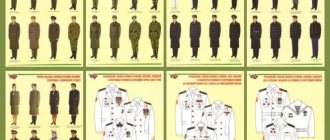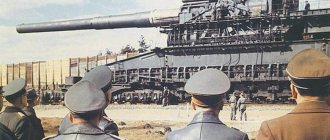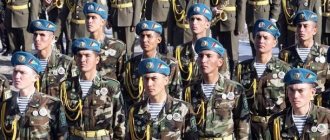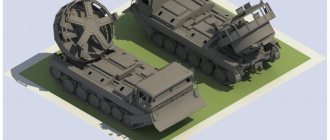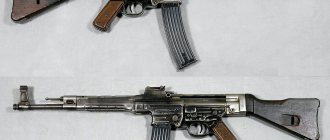The Russian army today is one of the most combat-ready in the world. According to the Global Firepower Index portal, the armed forces of the Russian Federation occupy second place in the ranking of the most powerful armies in the world, second only to the United States. The world-famous T-90 tanks, aviation and the latest missile systems, as well as qualified officers, have transformed the army. And today, Russian troops can compete with any army in the world. Thanks to good funding and a competent command that is capable of solving complex problems, the power of the Russian army is growing every day.
R-36M
What is
Before us is the legendary “Satan” according to the Western classification: a silo complex with a liquid-fuel intercontinental ballistic missile (ICBM). Russia now has more than 40 R-36M/R-36M2 systems with approximately 460 warheads.
What is the significance
The R-36M is a rather old complex: it was put into service in 1975. But missiles of this type are still the most powerful of all intercontinental ballistic missiles in the world. The R-36M2 Voevoda can carry an 8 Mt monoblock unit or ten warheads with a yield of 800 Kt. In the future, the basis of the Russian nuclear forces will be solid-fuel (and therefore safer to operate) missiles.
R-36M / ©Wikiwand
Army history
Although the Russian army has existed for only a few decades, the history of the Russian army itself goes back many centuries. To survive, the Russians had to have combat-ready troops at the end of the millennium before last. The backbone of the modern Russian army and the Russian troops at earlier stages were strong, intelligent and courageous commanders-in-chief. And it is precisely thanks to this that Russia managed to maintain its sovereignty for most of its history.
The Russian Federation is the successor state of the Soviet Union. The surviving military-industrial complex of the USSR was greatly weakened during the 90s. And the military campaigns in the Chechen Republic showed all the shortcomings of the Russian troops. With the onset of the 2000s, the power of the Russian army began to grow, due to its reformation. The system of recruitment and command and control of troops changed, funding increased, and the weapons of the army itself were modernized. This allowed Russia to be on the list of leaders in terms of the number and quality of its armed forces.
"Topol M"
What is
RT-2PM2 “Topol-M” became the first complex with an intercontinental ballistic missile, which they finished developing in the independent Russian Federation. There are two options - mine-based and mobile-based.
What is the significance
"Topol-M" is a weapon of guaranteed retaliatory strike. With a maximum range of 11,000 km, it can hit even the most remote strategically important object. The Topol-M missile is much inferior to the R-36M in terms of destructive impact - it has only one warhead with a capacity of 550 Kt. On the other hand, Topol-M is safer, and it also has modern technologies for overcoming missile defense.
Topol-M / ©militaryarms
PC-24 "Yars"
What is
PC-24 "Yars" is a silo-based and mobile complex with a solid-fuel ballistic missile with a multiple warhead. The number of combat units is 3–6. The charge power is approximately 300 kt. Maximum range - 12 thousand km. In total, Russia has approximately 100 Yars.
What is the significance
After the refusal of further purchases of the Topol PC-24 Yars, it became the main hope of the Russian nuclear triad. It is this rocket that will replace, in particular, the already mentioned “Satan”. Among the advantages is the widespread use of anti-missile defense measures. The PC-24 uses active jammers, aerosols, infrared radiation sources and quasi-heavy decoys.
RS-24 / ©wikipedia
667BDRM "Dolphin"
What is
A series of seven Soviet nuclear submarines armed with R-29RM ballistic missiles. The base for the boat was the Project 667BDR submarine “Kalmar” of the second generation. Subsequently, the submarines were re-equipped with the R-29RMU2 “Sineva” and R-29RMU2.1 “Lainer” missiles. There are a total of 16 ballistic missiles on board the submarine.
What is the significance
The importance of the maritime component of the nuclear triad is difficult to overestimate: it is very difficult to detect a boat; it can launch missiles from almost anywhere in the World Ocean. The main hope for the Russian Federation in this case was the Project 955 Borey boat with Bulava ballistic missiles. The latter is still being tested, and so far the percentage of unsuccessful launches is too high to consider this rocket a full replacement for existing ones. So the old Dolphins will still serve.
667BDRM "Dolphin". Model / ©shipsmodel
Number and quality of weapons
Today, the annual funding of the Russian army is 47 billion US dollars. The total number of soldiers in the army is 766 thousand, not counting 2.5 million active reserve personnel. In total there are about 50 million people suitable for military service. The military equipment of the Russian Federation is extremely diverse. Below is the number of different types of weapons of the Russian Federation:
- 15,400 tanks.
- 31,300 armored personnel carriers.
- 5972 self-propelled guns.
- 3547 aircraft.
- 1 aircraft carrier.
- 60 submarines.
- 4 frigates.
- 15 destroyers.
- 81 Corvette-class warships.
The power of the Russian army is amazing. Active investment in scientific developments allows us to equip the Russian army with advanced technologies. Many of the military equipment currently used by Russia are the legacy left to it by the Soviet Union. Here is a short list of outdated models of military equipment:
- Tanks: T-72, T-80, BTR-80, BMP-1, BMP-2 and BMP-3, BMD-1, BMD-2 and BMD-3.
- Rocket and cannon artillery: MLRS “Grad”, “Uragan”, “Smerch”.
- Aviation: MiG-29, Su-27, Su-25 and Su-24.
In the 90s, the situation with the modernization of the army was simply catastrophic. However, today the process of rearmament is in full swing. The modern Russian army is capable of repelling any enemy. Our troops must be maintained in proper condition to correctly defend the interests of the Russian Federation. The new T-90 and Armata tanks not only keep up with their Western counterparts, but are also ahead of them, and achievements in aviation (Su-35, Su-30, Su-34) give hope for the development of the aircraft manufacturing industry. The new, fifth-generation PAK FA fighter is currently being tested. The Russian Navy is also actively rearming. New missile-carrying submarines of the Borei class regularly replenish the forces of the Russian Navy. Re-equipment is underway in the field of rocket science, for example, a new Sarmat rocket was recently created. Russian tactical missile systems (such as the Iskander) began to play an important role.
Tu-160
What is
The Tu-160 is a supersonic strategic bomber that carries both nuclear and “conventional” weapons. The main purpose is to launch X-55 cruise missiles with nuclear warheads at strategically important enemy targets. A total of 12 X-55 missiles can be stored in the internal compartments. In Syria, Tu-160s also launched new non-nuclear cruise missiles Kh-101.
What is the significance
It is the world's only supersonic strategic bomber capable of carrying nuclear weapons. By the way, the United States has withdrawn its B-1B and B-2 from its nuclear forces. The ability to develop supersonic speed can be useful in breaking through the air defense of a potential enemy. Another Russian “strategist” - Tu-95 - does not have such capabilities. The maximum combat load of the Tu-160 is 45 tons: this is higher than that of the Tu-95, B-2 and B-52.
Tu-160 / ©Avia
As long as the Russian soldier is alive, Russia's military power has no competitors
In the world ranking of the most militarily powerful powers in the world, Russia ranks second in the eyes of Western analysts. But with her army the situation is more complicated
On the eve of the presentation by the International Institute of Strategic Studies (IISS) of the annual report “Military Balance”, Tsargrad published its own ranking of the most powerful armies in the world. It turned out to be somewhat ambiguous: leading Russian military experts ranked the top three as follows: USA, Russia, China. But taking into account such intangible factors as real combat experience, fighting spirit, etc., in the final rating of “Constantinople” the Russian army still came out on top.
Consider resources
It is possible to add another examination to this. It is regularly conducted by the international analytical group Global Firepower Index (GFP). Despite the fact that this is a Western product, it is recognized as quite authoritative. First of all, thanks to the approach: in their rating, analysts take into account not only the number of soldiers and weapons, but also a number of objective parameters of the countries under consideration. In fact, why does the Vatican need divisions if there is nowhere to place them, and all the gross income from tourists will be spent on food?
Here's how the rating authors themselves formulate their criteria:
The first is human resources. They are beyond the scope of military equipment and purely combat strength, because military strength is built on them: in a war of attrition, the country that has more manpower at its disposal has a better chance. So this is how they count: total population - available personnel - fit for duty - those of military age - total military personnel - active military personnel - active reserve.
The second is the air force. Because this is, they say, “one of the important components of modern military force.” All aviation personnel are included: fighters, attack aircraft, bombers, transport and training aircraft, helicopters, including attack aircraft.
Tu-160. Photo: www.globallookpress.com
All combat vehicles are also taken into account - battle tanks, BMP-armored personnel carriers, self-propelled and towed artillery, and multiple launch rocket systems.
It’s the same with the fleet - everything is considered: aircraft carriers, including helicopter carriers (because “the popularity of the latter is growing all over the world”), submarines all together (both nuclear and diesel-electric), destroyers, frigates and corvettes, as well as auxiliary vessels. Only... cruisers are not taken into account, as if their importance on the world stage has fallen below the plinth. Well, yes, say it in the presence of the crew of Peter the Great.
But then comes what makes the GFP rating truly significant—natural resources.
The first is oil: “as vital as any weapons system” - this is the play on words made by Western experts. So, oil production, its consumption, proven reserves.
Then - logistics, because “war is a battle of logistics, moving people and machines from point to point.” This means that these are the corresponding labor reserves, cargo ships, main ports and terminals, the length of highways and railways, and the number of operating airports.
Finance. Where would we be without them? Because "warfare goes beyond mere physical 'strength in numbers', relying heavily on funding." This means: defense budget, external debt, gold and foreign exchange reserves, GDP at purchasing power parity.
Finally, geographical conditions are also taken into account: the area of the country, coastline, common borders, length of waterways.
In general, more than 50 different factors are taken into account. As a result, we get not so much military power as the potential power of the military economy. Even more than non-military power, because nuclear weapons are not taken into account in the assessment, some types of ships that the United States does not have, but Russia does, are not taken into account, the coastline, which does not play a special role for states with threatened land borders, on the contrary, is taken into account. Etc.
Western ratings are so Western...
Still interesting, although some things are doubtful
But one way or another, the Global Firepower Index looks like this for last year: in first place - out of 133 countries taken into account - is the United States of America with a complex score of 0.0857 (ideally it should be 0.0000).
US Army soldiers. Photo: www.globallookpress.com
It is logical if we discard the above points: population - 323.9 million, armed forces - 2.36 million, aviation - 13,762 vehicles, tanks and armored fighting vehicles - 5,884 units. The number of ships is 415, of which 19 are aircraft carriers and 70 are submarines. The defense budget is the largest in the world, larger than all others combined. In the document, it is stated in the amount of $587.8 billion. But it is worth recalling that in 2018 the US Congress allocated more than $700 billion for military spending.
In second place is Russia with 0.0929 points: 142 million people, but the number of armed forces is indicated at 3.37 million people (in fact, Tsargrad cited this data from official sources: under the command of the Russian Ministry of Defense there are a little more than a million military personnel ). Russia has 3,794 aviation assets, 20,216 armored vehicles, 352 warships, without aircraft carriers (one aircraft-carrying cruiser), but with 63 submarines. Experts estimated the military budget at $44.6 billion.
China took bronze in the ranking, receiving 0.0945 points. The population is 1.373 billion, the number of armed forces is 3.7 million, the aviation industry has 2,955 airplanes and helicopters, tanks and armored fighting vehicles—6,457. It turns out funny with the fleet: 714 warships are announced in the rating, which is one and a half times more than the entire American Navy! The Chinese defense budget has been announced at $161.7 billion.
Chinese Army. Photo: www.globallookpress.com
Then there is almost complete coincidence with the Tsargrad rating: 4th place for India (index 0.1593), 5th place for France (0.1914), then Britain (0.2131), Japan (0.2137), Turkey (0.2491), Germany (0.2609) and Egypt (0.2676).
True, we did not include Egypt in our ranking at all, but since the Americans place fundamental importance on aircraft carriers, our two helicopter carriers sold to Cairo gave it an honorable place in the top ten. But let's be honest: Egypt's military power and Germany's military power cannot be compared. Contrary to any cunning indexes.
Some other assessments also raise questions. But it is not important. Ultimately, all these ratings are nothing more than entertainment. The military strength of a country is determined by the soldiers on the battlefield. So as long as Russia has a Russian soldier, its military power will have no competitors.






